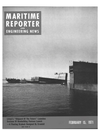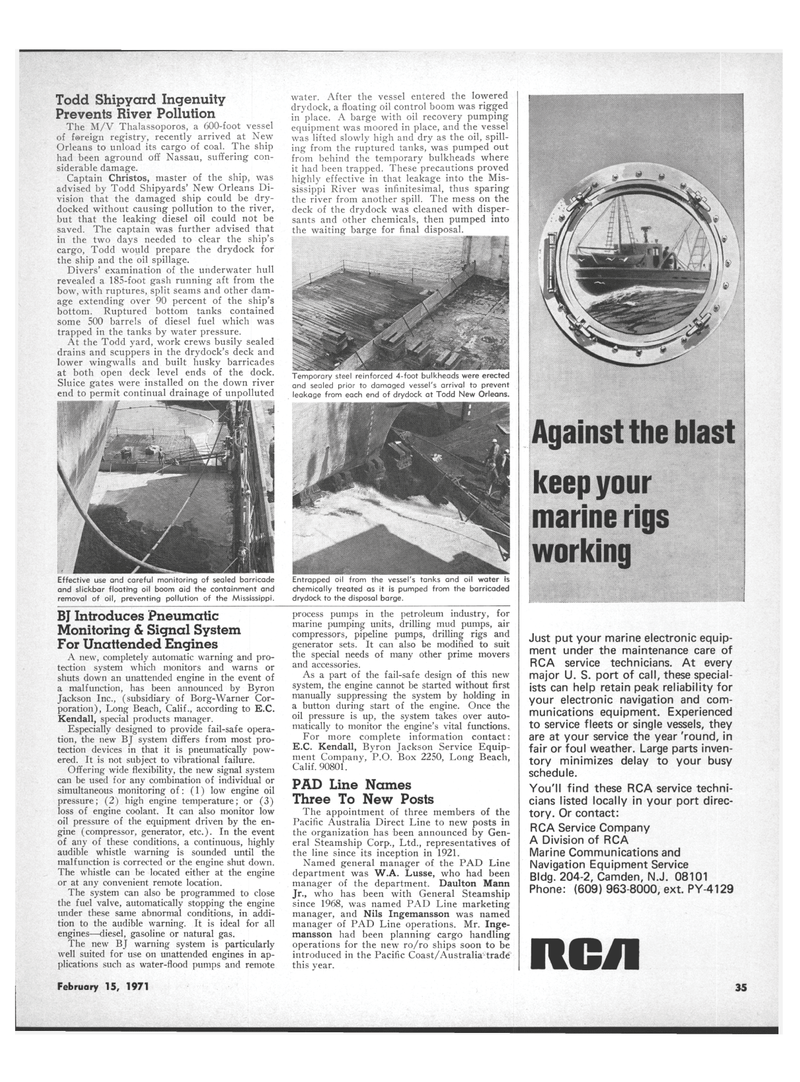
Page 31: of Maritime Reporter Magazine (February 15, 1971)
Read this page in Pdf, Flash or Html5 edition of February 15, 1971 Maritime Reporter Magazine
Todd Shipyard Ingenuity
Prevents River Pollution
The M/V Thalassoporos, a 600-foot vessel of fsreign registry, recently arrived at New
Orleans to unload its cargo of coal. The ship had been aground off Nassau, suffering con- siderable damage.
Captain Christos, master of the ship, was advised by Todd Shipyards' New Orleans Di- vision that the damaged ship could be dry- docked without causing pollution to the river, but that the leaking diesel oil could not be saved. The captain was further advised that in the two days needed to clear the ship's cargo, Todd would prepare the drydock for the ship and the oil spillage.
Divers' examination of the underwater hull revealed a 185-foot gash running aft from the bow, with ruptures, split seams and other dam- age extending over 90 percent of the ship's bottom. Ruptured bottom tanks contained some 500 barrels of diesel fuel which was trapped in the tanks by water pressure.
At the Todd yard, work crews busily sealed drains and scuppers in the drydock's deck and lower wingwalls and built husky barricades at both open deck level ends of the dock.
Sluice gates were installed on the down river end to permit continual drainage of unpolluted
Effective use and careful monitoring of sealed barricade and slickbar floating oil boom aid the containment and removal of oil, preventing pollution of the Mississippi.
BJ Introduces Pneumatic
Monitoring & Signal System
For Unattended Engines
A new, completely automatic warning and pro- tection system which monitors and warns or shuts down an unattended engine in the event of a malfunction, has been announced by Byron
Jackson Inc., (subsidiary of Borg-Warner Cor- poration), Long Beach, Calif., according to E.C.
Kendall, special products manager.
Especially designed to provide fail-safe opera- tion, the new BJ system differs from most pro- tection devices in that it is pneumatically pow- ered. It is not subject to vibrational failure.
Offering wide flexibility, the new signal system can be used for any combination of individual or simultaneous monitoring of: (1) low engine oil pressure; (2) high engine temperature; or (3) loss of engine coolant. It can also monitor low oil pressure of the equipment driven by the en- gine (compressor, generator, etc.). In the event of any of these conditions, a continuous, highly audible whistle warning is sounded until the malfunction is corrected or the engine shut down.
The whistle can be located either at the engine or at any convenient remote location.
The system can also be programmed to close the fuel valve, automatically stopping the engine under these same abnormal conditions, in addi- tion to the audible warning. It is ideal for all engines—diesel, gasoline or natural gas.
The new BJ warning system is particularly well suited for use on unattended engines in ap- plications such as water-flood pumps and remote process pumps in the petroleum industry, for marine pumping units, drilling mud pumps, air compressors, pipeline pumps, drilling rigs and generator sets. It can also be modified to suit the special needs of many other prime movers and accessories.
As a part of the fail-safe design of this new system, the engine cannot be started without first manually suppressing the system by holding in a button during start of the engine. Once the oil pressure is up, the system takes over auto- matically to monitor the engine's vital functions.
For more complete information contact:
E.C. Kendall, Byron Jackson Service Equip- ment Company, P.O. Box 2250, Long Beach,
Calif. 90801.
PAD Line Names
Three To New Posts
The appointment of three members of the
Pacific Australia Direct Line to new posts in the organization has been announced by Gen- eral Steamship Corp., Ltd., representatives of the line since its inception in 1921.
Named general manager of the PAD Line department was W.A. Lusse, who had been manager of the department. Daulton Mann
Jr., who has been with General Steamship since 1968, was named PAD Line marketing manager, and Nils Ingemansson was named manager of PAD Line operations. Mr. Inge- mansson had been planning cargo handling operations for the new ro/ro ships soon to be introduced in the Pacific Coast/Australia trade' this year.
Just put your marine electronic equip- ment under the maintenance care of
RCA service technicians. At every major U. S. port of call, these special- ists can help retain peak reliability for your electronic navigation and com- munications equipment. Experienced to service fleets or single vessels, they are at your service the year 'round, in fair or foul weather. Large parts inven- tory minimizes delay to your busy schedule.
You'll find these RCA service techni- cians listed locally in your port direc- tory. Or contact:
RCA Service Company
A Division of RCA
Marine Communications and
Navigation Equipment Service
Bldg. 204-2, Camden, N.J. 08101
Phone: (609) 963-8000, ext. PY-4129
Against the blast keep your marine rigs working water. After the vessel entered the lowered drydock, a floating oil control boom was rigged in place. A barge with oil recovery pumping equipment was moored in place, and the vessel was lifted slowly high and dry as the oil, spill- ing from the ruptured tanks, was pumped out from behind the temporary bulkheads where it had been trapped. These precautions proved highly effective in that leakage into the Mis- sissippi River was infinitesimal, thus sparing the river from another spill. The mess on the deck of the drydock was cleaned with disper- sants and other chemicals, then pumped into the waiting barge for final disposal.
Temporary steel reinforced 4-foot bulkheads were erected and sealed prior to damaged vessel's arrival to prevent leakage from each end of drydock at Todd New Orleans.
Entrapped oil from the vessel's tanks and oil water is chemically treated as it is pumped from the barricaded drydock to the disposal barge.
February 35, 1971 13

 30
30

 32
32
